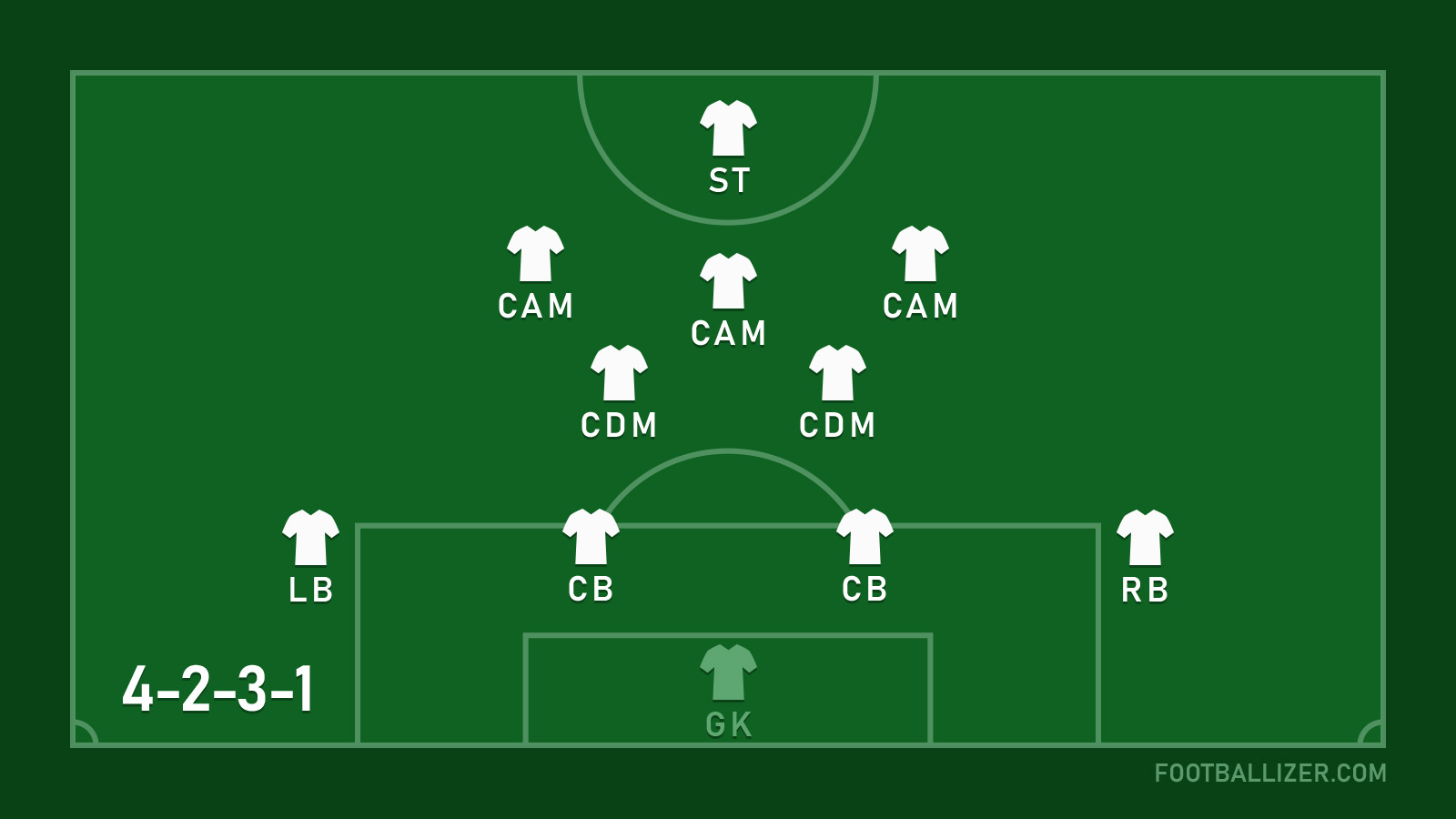4-2-3-1 Formation

The 4-2-3-1 formation, a versatile and widely adopted tactical setup, provides a balanced structure that combines defensive solidity with potent attacking capabilities. Known for its adaptability, the formation is often regarded as both defensive and attacking, offering a well-rounded approach to the game. Comprising four defenders, two defensive midfielders, three attacking midfielders, and a lone striker, the 4-2-3-1 formation creates a formidable presence on the field. Here's a breakdown of each position:
Defenders - The defensive quartet typically includes two central defenders and two fullbacks. Their primary duty is to safeguard the goal, showcasing strong defensive skills, positional awareness, and the ability to initiate plays from the back. Fullbacks are crucial for providing width in attack, making overlapping runs, and delivering crosses into the box.
Defensive Midfielders - Positioned just in front of the defense, the two defensive midfielders act as shields, breaking up opposition plays and distributing the ball to initiate attacks. They must possess excellent tackling, interception, and passing abilities, serving as the link between the defense and the attacking midfielders.
Attacking Midfielders - The trio of attacking midfielders operates just behind the lone striker, emphasizing creativity and playmaking. These players need to be technically skilled, possess vision, and excel in passing. They have the dual role of creating goal-scoring opportunities and providing support to the lone striker.
Striker - The lone striker spearheads the attack, aiming to convert opportunities into goals. This player must be a clinical finisher, capable of holding up play to involve the attacking midfielders. The striker's movement and ability to exploit defensive vulnerabilities are vital for the team's success.
The 4-2-3-1 formation is praised for its flexibility, allowing teams to adjust their style of play based on the strengths of the squad and the tactical requirements of a given match. Whether focusing on a possession-based approach or seeking quick counter-attacks, the formation provides a solid foundation for teams aiming to balance defensive resilience with attacking flair.
Advantages
Defensive Solidity
The two defensive midfielders provide a solid shield in front of the defensive line, making it difficult for the opposition to penetrate through the center of the pitch. The four defenders and two defensive midfielders create a compact defensive unit, making it challenging for opponents to find spaces and exploit defensive weaknesses.
Control in Midfield
With two central midfielders and an attacking midfielder in the "number 10" role, the 4-2-3-1 formation allows a team to control the midfield. This is crucial for dictating the tempo of the game and retaining possession.
Versatility in Attack
The formation allows for a versatile attacking setup. The lone striker up front can benefit from the support of three attacking midfielders who have the freedom to roam and create goal-scoring opportunities. The wide attacking players (wingers) provide width, stretching the opposition's defense and creating space for central players to exploit.
Counterattacking Potential
The 4-2-3-1 formation is well-suited for quick counterattacks. The defensive structure provides stability, and with fast wingers and a mobile striker, teams can transition rapidly from defense to attack.
Disadvantages
Vulnerability to Counterattacks
The attacking nature of the formation, with full-backs pushing forward and midfielders joining the attack, can leave the team susceptible to counterattacks. If possession is lost high up the pitch, there might be space behind the defensive line.
Isolation of the Striker
The lone striker up front may become isolated if not adequately supported by the attacking midfielders. If the team struggles to connect the midfield with the striker, it can limit goal-scoring opportunities.
Overreliance on Full-backs
The full-backs in a 4-2-3-1 formation are often expected to contribute both defensively and offensively. Depending too much on full-backs for width can lead to fatigue and defensive vulnerabilities when they are caught out of position.
Midfield Overrun
Against teams with a strong central midfield or numerical superiority in the middle of the park, the 4-2-3-1 may struggle to control possession, and the defensive midfielders may find themselves overwhelmed.
Defensive Gaps in Transition
When transitioning from attack to defense, the quick movement of attacking players can leave gaps in the defensive structure. If the opposition can exploit these gaps, it may lead to defensive vulnerabilities.
How to Counter 4-2-3-1 Formation?
Overload the Midfield: Employ a midfield trio to disrupt the 4-2-3-1, outnumbering their defensive midfielders and limiting control in the center.
Exploit Wide Areas: With only two defensive midfielders, target the wings to stretch the defensive shape, creating space for scoring opportunities.
Press High and Force Mistakes: Apply high-pressure tactics to disrupt build-up play, force mistakes, and capitalize on turnovers in advanced positions.
Isolate the Lone Striker: Cut off supply lines to the lone striker, isolating them from support and reducing the effectiveness of the attack.
Exploit Defensive Full-backs: Target spaces left by advanced full-backs, forcing them to defend and limiting their contributions to the attack.
Defend Narrowly: Compact the defensive shape to make it difficult for the attacking midfield trio to find space through the center.
Man-Mark Key Players: Disrupt the flow by assigning specific players to man-mark key individuals, such as the central attacking midfielder and defensive midfielders.
Switch Formations: Alter the team's formation to exploit weaknesses, favoring setups with a strong midfield presence.
Use Target Man Against High Line: Exploit a high defensive line by utilizing a target man for direct balls, exploiting space behind the defense.
Exploit Set Pieces: Take advantage of set-piece situations, capitalizing on defensive lapses during corners or free kicks.
Suggested Counter Formations
- 4-3-3
- 4-1-4-1
- 4-5-1
- 3-5-2
- 5-4-1